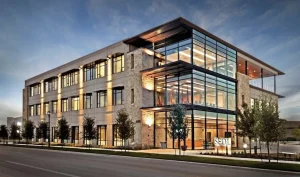Within commercial building planning, blending form and function drives architectural innovation. Architects strive to fuse utility with visual charm, posing a key question: How to infuse artistic flair into commercial structures beyond mere functionality?
By exploring the challenges of harmonizing aesthetic design with practical needs, we unveil the transformative potential of merging beauty and purpose in commercial architecture.
Key Takeaways
- Aesthetic design plays a crucial role in enhancing brand identity and improving customer perception in commercial buildings.
- Incorporating sustainable construction practices not only benefits the environment but also adds value to the property.
- Maximizing space efficiency through innovative design solutions can boost employee morale and productivity.
- Balancing functionality with aesthetic appeal is essential for meeting modern business demands and differentiating from competitors in the commercial building sector.
Challenges in Commercial Building Planning
Navigating the intricate landscape of commercial building planning poses a myriad of challenges that demand meticulous attention to detail and innovative problem-solving approaches. One of the primary challenges in commercial building ideas is striking a harmonious balance between functionality and aesthetic appeal. Designing a space that not only meets the practical needs of its occupants but also exudes a sense of style and sophistication requires a delicate blend of creativity and precision.
Furthermore, another hurdle often faced in commercial building ideas is ensuring compliance with building codes and regulations while still pushing the boundaries of design innovation. Striking this balance between adherence to legal requirements and the integration of cutting-edge design elements can be a complex task that necessitates out-of-the-box thinking and a deep understanding of the regulatory landscape.
In addition, the evolving demands of modern businesses add another layer of complexity to commercial building planning. Flexibility, sustainability, and technology integration are now key considerations in creating spaces that cater to the ever-changing needs of today’s organizations. Successfully navigating these challenges requires a commitment to staying ahead of trends and embracing a mindset of continuous improvement and innovation.
Importance of Aesthetic Design
With meticulous attention to detail and innovative problem-solving approaches, the significance of aesthetic design in commercial building planning cannot be overstated. Aesthetic design goes beyond mere visual appeal; it plays a crucial role in enhancing the functionality, sustainability, and overall experience of a commercial space. Here are five key reasons why aesthetic design is essential in commercial building planning:
- Enhances Brand Identity: A well-designed commercial building can serve as a physical representation of a company’s values, culture, and brand image.
- Improves Customer Perception: Aesthetically pleasing buildings create a positive first impression on customers, potentially increasing foot traffic and sales.
- Boosts Employee Morale: Thoughtfully designed workspaces can enhance employee satisfaction, productivity, and overall well-being.
- Differentiates from Competitors: Unique and visually appealing designs set a commercial building apart from competitors in the market.
- Increases Property Value: Aesthetic considerations can significantly impact the resale and rental value of commercial properties, offering long-term financial benefits.

Integrating Artistic Elements
The infusion of artistic elements into commercial building planning elevates not only the aesthetic appeal but also the overall functionality and experiential quality of the space. By integrating art into the design process, commercial buildings can become more than just structures; they transform into dynamic environments that engage inhabitants on multiple levels. Artistic elements bring a sense of creativity and innovation, sparking inspiration and fostering a sense of belonging within the space.
When artistic flair is incorporated into planning for commercial building, it goes beyond mere decoration. Art has the power to communicate ideas, evoke emotions, and create memorable experiences for those who interact with the space. Whether through murals, sculptures, or interactive installations, art can shape the atmosphere of a commercial building, making it a place where people want to spend time and connect with others.
Incorporating artistic elements into commercial building planning is not just about aesthetics but about creating a holistic environment that stimulates the senses and nurtures a sense of community and belonging among its users.
Enhancing Functionality Through Design
Enhancing efficiency and user experience is paramount in the intricate process of commercial building design. The functionality of a commercial building can be significantly enhanced through thoughtful design considerations. Here are five key ways to achieve this:
- Flexible Layouts: Designing versatile spaces that can adapt to different needs promotes efficiency and maximizes usability.
- Natural Light Integration: Incorporating ample natural light not only reduces energy costs but also creates a more pleasant and productive environment for occupants.
- Smart Technology Integration: Implementing smart building technologies can streamline operations, improve security, and enhance the overall user experience.
- Efficient Traffic Flow: Careful planning of entrances, exits, and circulation paths can prevent congestion and ensure a smooth flow of people within the building.
- Sustainable Design Practices: Prioritizing eco-friendly materials and energy-efficient systems not only reduces the building’s environmental impact but also contributes to a healthier indoor environment for occupants.
Maximizing Space Efficiency
Maximizing space efficiency in commercial building design extends the foundational principles of functionality, emphasizing the strategic utilization of available areas to enhance productivity and usability. The efficient use of space is crucial in creating a harmonious environment that fosters creativity, collaboration, and overall well-being within a commercial setting. By carefully analyzing the layout and flow of a space, designers can optimize every square footage to serve a specific purpose, whether it be for workstations, meeting rooms, or communal areas.
Innovative solutions such as flexible furniture arrangements, multifunctional spaces, and smart storage solutions can significantly impact the efficiency of a commercial building. Integrating elements like modular partitions, sliding doors, and ergonomic furniture not only maximizes space but also contributes to a more dynamic and adaptable workspace.
Furthermore, incorporating natural light, greenery, and visually appealing design elements can create an inviting atmosphere that enhances the overall aesthetic while promoting a sense of belonging and well-being among occupants. Ultimately, maximizing space efficiency in commercial building planning is not just about utilizing space effectively but also about creating a space that inspires creativity and boosts productivity.
Achieving Sustainability in Design
Incorporating sustainable practices into commercial building design is essential for fostering environmental consciousness and resource efficiency. Embracing sustainability in design not only benefits the environment but also enhances the overall functionality and appeal of commercial spaces.
To achieve sustainability in commercial building planning, consider the following key factors:
- Energy-Efficient Systems: Implementing energy-efficient heating, ventilation, and air conditioning (HVAC) systems can significantly reduce energy consumption.
- Natural Light Optimization: Designing spaces that maximize natural light exposure can decrease the reliance on artificial lighting and lower energy usage.
- Water Conservation Strategies: Incorporating water-saving fixtures and systems helps reduce water wastage and promotes efficient water use.
- Green Building Materials: Choosing eco-friendly and sustainable materials for construction minimizes environmental impact and enhances building longevity.
- Waste Management Plans: Developing effective waste management strategies, such as recycling programs, contributes to reducing landfill waste and promoting a greener environment.
Frequently Asked Questions
How Can Innovative Technology Be Incorporated Into Commercial Building Planning to Improve Efficiency?
Incorporating innovative technology in commercial building planning enhances efficiency by streamlining processes, optimizing energy consumption, and improving maintenance. Smart systems like IoT sensors, Building Information Modeling (BIM), and automated controls are key tools for achieving these advancements.
What Role Does Natural Lighting Play in Enhancing the Aesthetic Design of Commercial Buildings?
Natural lighting enhances commercial building aesthetics by creating a welcoming environment, reducing energy costs, and boosting occupant productivity. When strategically incorporated, it adds warmth, showcases architectural features, and promotes a connection with the outdoors, elevating the overall design.
Are There Any Specific Regulations or Guidelines That Need to Be Considered When Integrating Artistic Elements Into Commercial Building Planning?
When integrating artistic elements into commercial building planning, it is essential to adhere to relevant regulations and guidelines. These may include zoning ordinances, building codes, ADA requirements, and specific design standards to ensure compliance and safety.
How Can Collaborative Spaces Be Incorporated Into the Design of Commercial Buildings to Promote Creativity and Productivity?
Collaborative spaces in commercial buildings can boost creativity and productivity by incorporating flexible layouts, inspiring decor, and interactive technology. Thoughtful design elements like breakout areas, shared workspaces, and natural lighting foster teamwork and innovation.
What Are Some Creative Ways to Incorporate Sustainable Materials and Practices Into the Construction of Commercial Buildings While Maintaining Aesthetic Appeal?
Incorporating sustainable materials in commercial building construction while maintaining aesthetic appeal involves utilizing eco-friendly materials like reclaimed wood, bamboo flooring, energy-efficient windows, and green roofs. Implementing solar panels, rainwater harvesting, and efficient insulation are key practices.
Conclusion
In conclusion, the fusion of aesthetics and functionality in commercial building planning is essential for creating visually striking yet practical spaces. By carefully integrating artistic elements, maximizing space efficiency, and achieving sustainability in design, architects and designers can elevate commercial buildings with artistic flair. This delicate balance between form and function not only enhances the visual landscape of our cities but also ensures that these spaces serve their purpose efficiently, standing as artistic landmarks in their own right.
You may also like:

